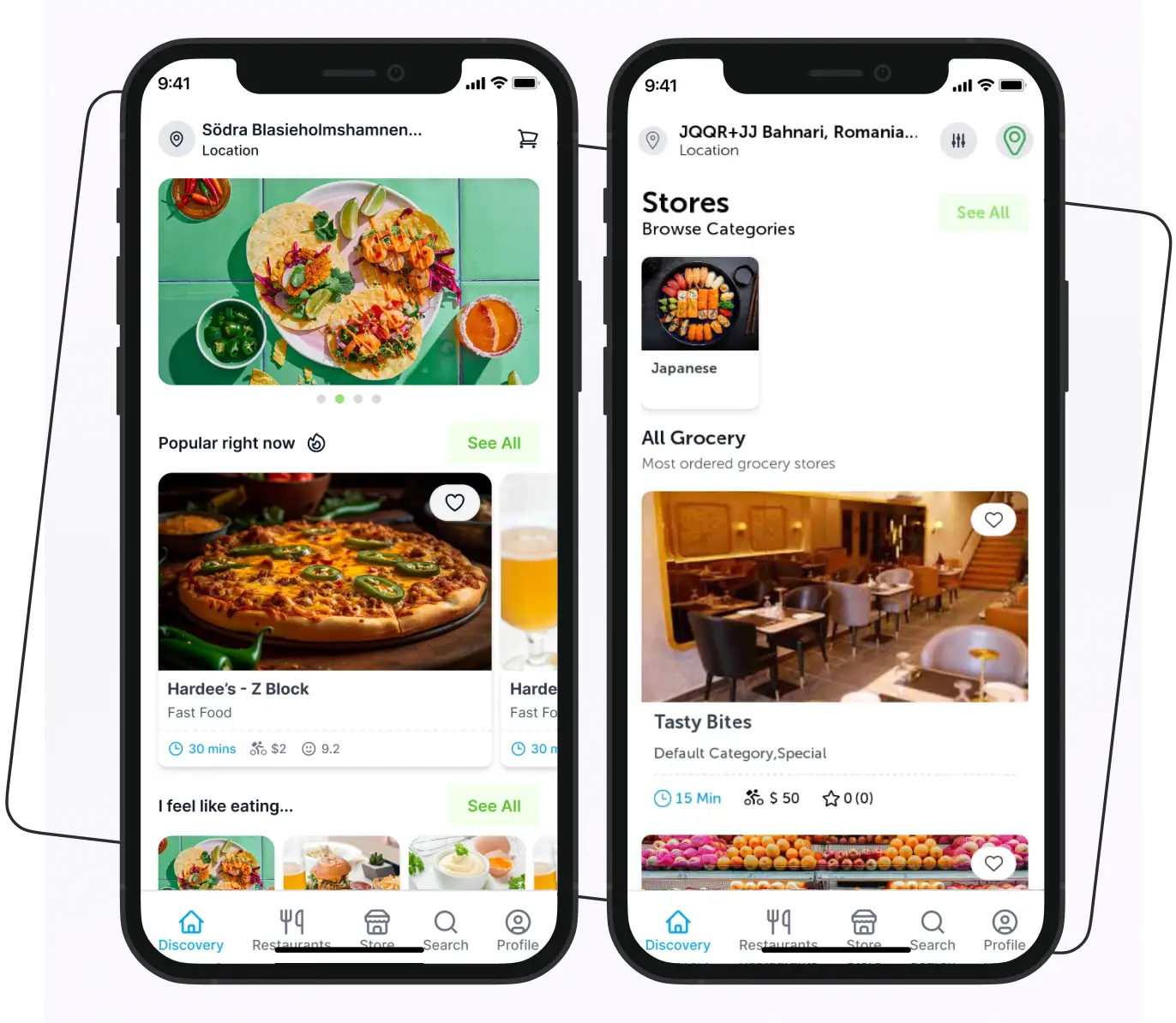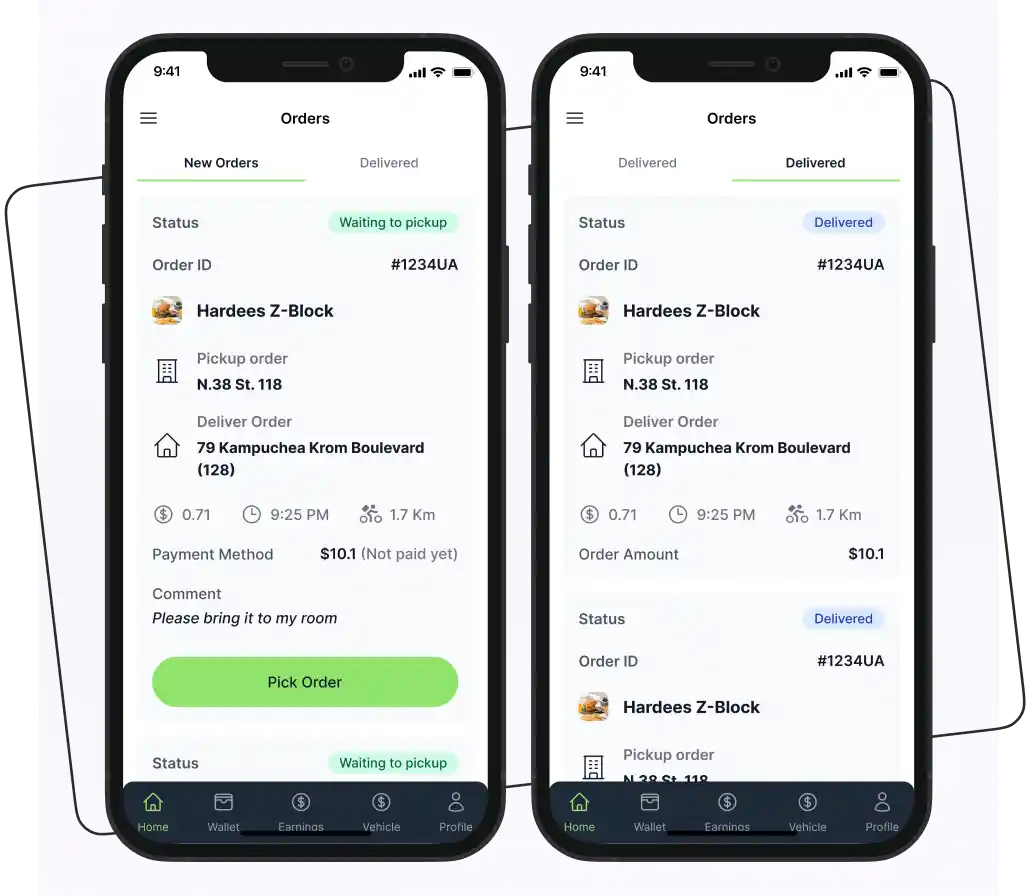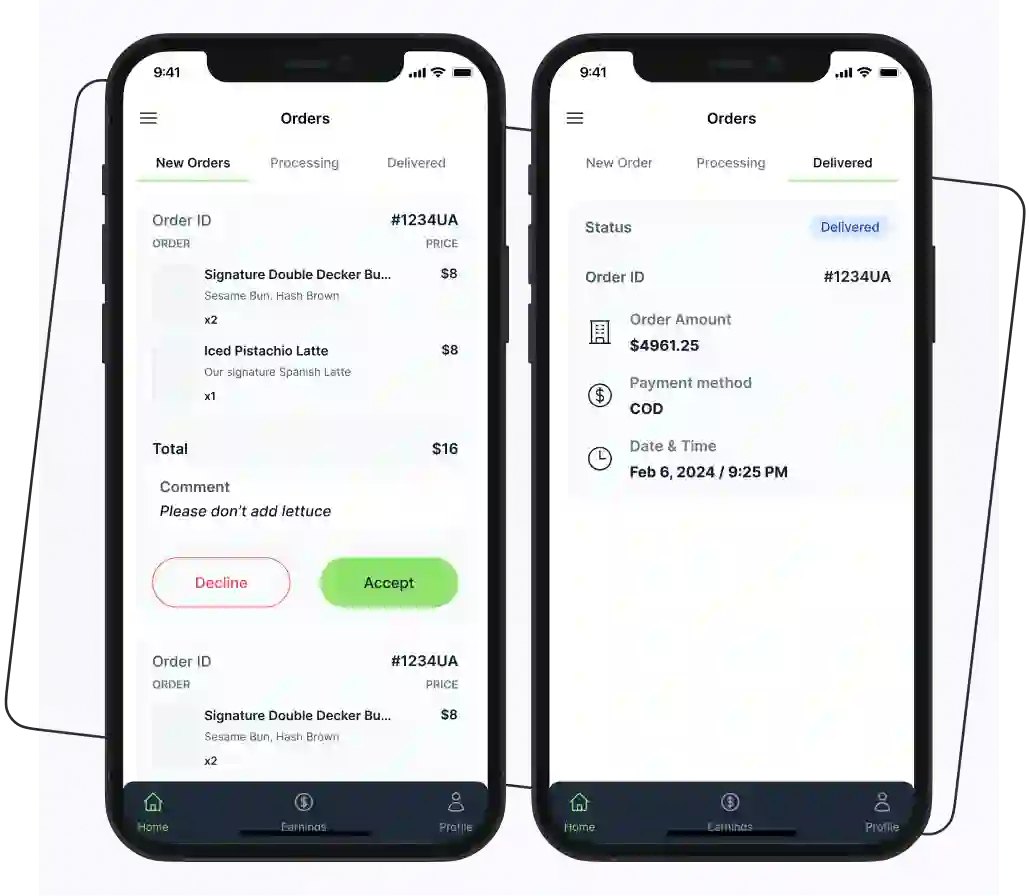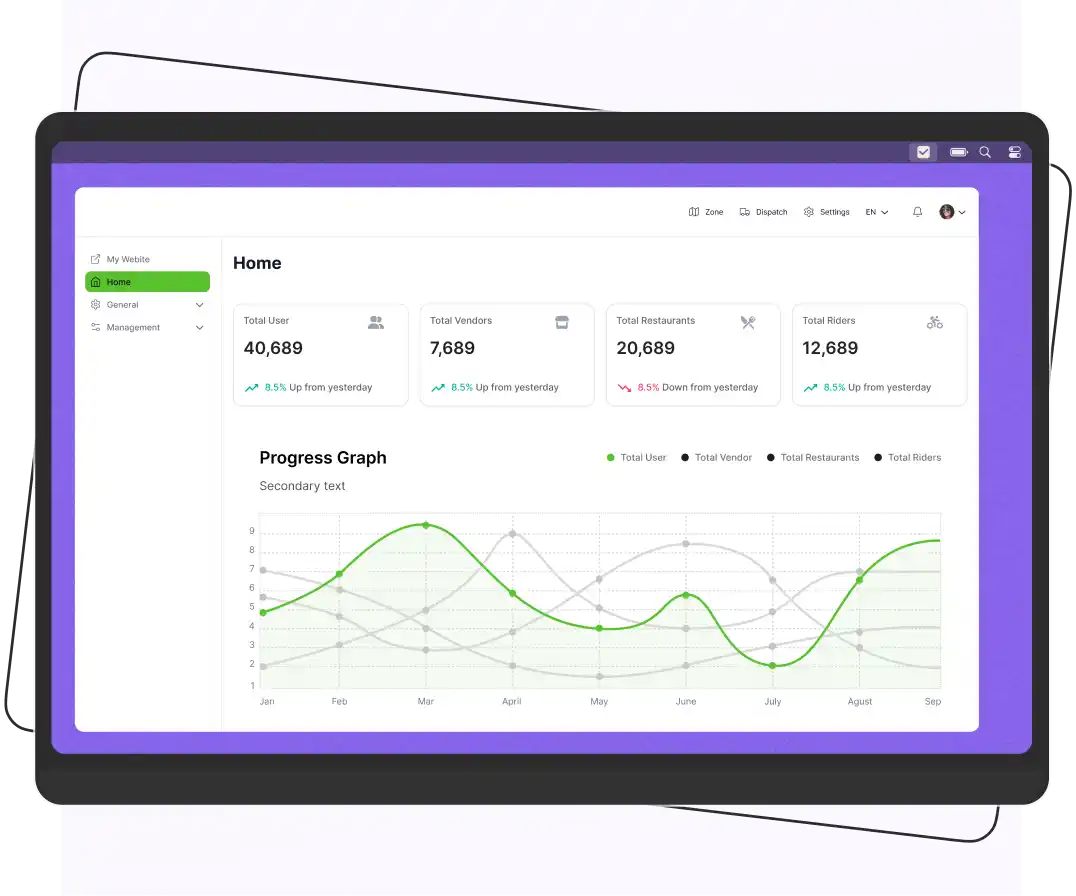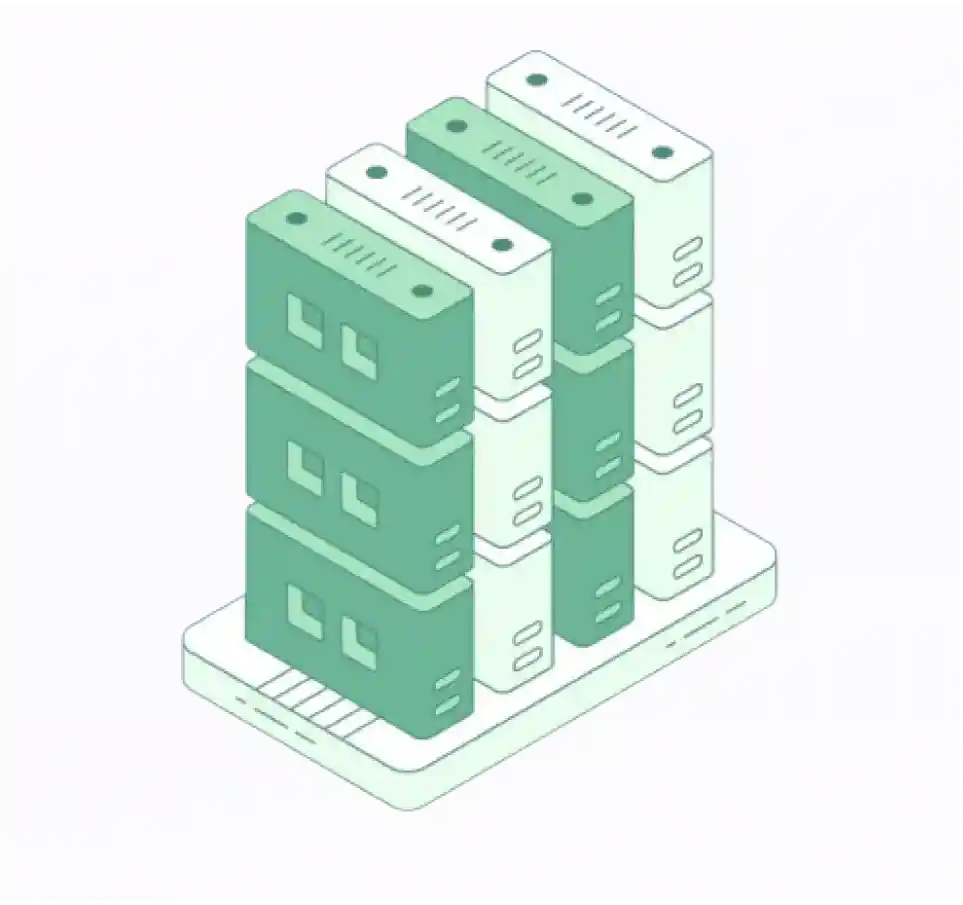
Now, every business owner is looking for ways to automate tasks and cut unnecessary expenses. This is especially true for grocery delivery services, where convenience is king.
Imagine a world where customers can have their groceries delivered right to their doorsteps with just a few taps on their smartphones. Sounds appealing.
With the grocery delivery market projected to reach $940.96 billion by 2025, now is the perfect time to get involved in this trend. Creating a grocery delivery app not only automates your operations but also enhances customer satisfaction, making it a smart move for your business.
In this blog, we’ll walk you through the essential steps to develop a standout grocery delivery app. From conducting in-depth market research to choosing the right technology stack, we have covered it all.
So, let’s explore.
How Does Grocery App Work?
Before developing a grocery app, it’s important to understand its functionality. Here are the main steps involved in how a grocery app works.

1. Download and Signup
Users begin by downloading the grocery app from the app store. They create an account by providing basic information such as their email address and password.
2. Browse Products
After signing up, users can browse through various categories, including fruits, vegetables, dairy, and snacks, making it easy to find what they need.
3. Search Function
The search feature allows users to type in specific items or brands, facilitating quick access to products without scrolling through multiple pages.
4. Add to Cart
Once users find their desired products, they can select quantities and add them to their virtual shopping cart for easy checkout later.
5. Apply Promo Code (If Any)
If users have promotional codes, they can enter them at checkout to receive discounts. It enhances their shopping experience and saves money.
Supercharge your deliveries with Enatega.
Schedule a Call Now6. Checkout
Users review their shopping cart to ensure they have everything they need. They can make adjustments before proceeding to the payment stage.
7. Payment Processing
The app securely processes payments, offering various methods such as credit/debit cards, digital wallets, or cash on delivery.
8. Order Confirmation
After payment, users receive an order confirmation via email or in-app notification, detailing their purchase and estimated delivery time.
9. Order Fulfilment
The grocery store then prepares the order, picking and packing the items as per the user’s selection and readying them for delivery.
10. Delivery
Finally, the order is delivered to the user’s specified address. The user also provides feedback based on their experience.
How to Create a Grocery Delivery App?
Creating a grocery delivery app is your golden opportunity to stand out in the competitive market. However, it requires careful planning and preparation.
Therefore, for your help, we gathered some steps to help you create a top-notch grocery delivery solution.

1. Market Research
Before you start creating your grocery delivery app, it’s important to understand your market and define what makes your app unique.
The success of your app relies on the information you gather during this stage. Without it, you won’t be able to compete effectively or identify gaps in the market that you can fill.
Here are some key areas to focus on:
- Identify Your Target Audience: Know who they are and what they want.
- Understand Market Trends: Stay updated on what’s popular in the grocery delivery industry.
- Analyze Competitors: Look at their strengths and weaknesses.
To gather this information, you can use various research methods, such as:
- Interviews
- Surveys
- Online databases
- Journals
- Observations
If you’re short on time, consider hiring professionals to help with your market research.
2. Choose the Business Model
Defining the business model is necessary if you want to create a grocery delivery app like Instacart. Select the business model that best aligns with your requirements.
Below are some grocery delivery app business models that you should consider when creating an app.
- Inventory Model
In this model, the grocery store owner is responsible for purchasing and storing inventory from various retailers in a warehouse. They are fully responsible for managing stock levels and ensuring the timely delivery of grocery orders to customers.
- Multi-Vendor Marketplace Model
Using the multi-vendor marketplace model, multiple sellers, like local farmers, large grocery chains, or specialty food stores, can sell their products directly to customers via a single platform.
This model is similar to a virtual grocery market where the platform earns a commission on each order.
In addition, this model is known as the “zero inventory model” as the owner of the platform does not hold any inventory on its own.
- Hyper-Local Model
The hyperlocal model refers to a model where customers can order groceries online from nearby local stores. The main unique selling proposition of this model is that they deliver groceries within a short time frame, usually within an hour, to the customer’s doorstep.
- Scheduled Delivery Model
This model enables grocery deliveries to be scheduled according to the needs of the retailer, delivery staff, and customers, ensuring convenience for all parties involved.
- BOPIS (Buy Online, Pick Up In-Store) Model
This grocery model allows customers to browse and order groceries online through a dedicated website or app and then have them physically pick them up at their chosen local grocery store. This combines the ease of online shopping with the immediacy of in-store pickup.
3. Identify the App Features
More and more people are moving to online grocery shopping. Therefore, it is pivotal to make their journey remarkable, and this can be done by providing great features.
Below are some great features that you should incorporate into your online grocery delivery service.
For Customers
| Features | Description |
| Simple Signup | Customers can easily sign up on the app using their email, phone number, or social media account. This process ensures that users can get started quickly without any complicated steps. |
| Custom Search | Users can take advantage of advanced search filters to find products that match their specific needs. Whether looking for a particular brand, price range, or dietary preference, these filters help users save time and make informed choices. |
| Multiple Payment Options | This essential feature offers various payment methods, including cash on delivery, credit/debit cards, and digital wallets. By providing multiple options, customers can choose the payment method that suits them best, ensuring a smooth and hassle-free checkout experience. |
| Multi-language Support | Users can access the app in multiple languages, allowing them to choose their preferred language for a better experience. This inclusivity helps break language barriers, making the app accessible to a wider audience. |
| Order Tracking | The order tracking feature lets users monitor the status of their orders in real time, from placement to delivery. Customers receive updates on their order’s journey, providing peace of mind and transparency throughout the process. |
| Ratings and Reviews | Customers can provide feedback on their experience by giving a star rating and writing a review. This feature not only helps other users make informed decisions but also help store owners to improve the services based on customer input. |
| Grocery Store Virtual Tour | Users can explore the grocery store virtually, making it easier to find products. This interactive feature allows customers to familiarize themselves with store layouts and locate items quickly, improving their shopping experience. |
| Push Notifications | Stay updated with timely notifications about order status, promotions, and more. These alerts keep customers informed about new offers and important updates, helping them stay engaged with the app. |
| In-app Chat | Customers can communicate directly within the app for support or inquiries. This feature provides a convenient way for users to get assistance, ensuring that their questions are answered promptly. |
For Grocery Store Owners
| Features | Description |
| Store Registration | Store registration is designed to be quick and straightforward, allowing owners to set up their accounts without unnecessary delays. This streamlined process helps new store owners get started with minimal hassle. |
| Product Management | With product management, store owners can easily add new items, update existing listings, and organize their inventory efficiently. This feature ensures that customers always have access to the latest products available in the store. |
| Order Management | The order management feature simplifies the tracking of all customer orders, making it easier to manage fulfillment and delivery. |
| Payment Management | Store owners can securely store their payment information and keep detailed records of all transactions. This feature provides transparency and simplifies financial management, making it easier to track sales and payments. |
| Order History Management | Accessing and managing the history of all orders is effortless with grocery delivery software. It allows store owners to keep track of all orders in one place and avoid mistakes that can occur if you handle it manually. |
For Riders
| Features | Description |
| Rider Registration | Riders can easily create an account on the app by entering their name, vehicle details, contact number and uploading identification documents. This process ensures they are ready to deliver groceries. |
| Order Notification | Riders receive instant push notifications whenever a new grocery order is placed, keeping them informed and ready to respond quickly. |
| Accept and Reject Orders | Riders have the flexibility to accept or reject incoming orders based on their availability, allowing them to manage their time effectively. |
| GPS Tracking | This feature enables real-time tracking of the rider’s location, helping them navigate efficiently to pick up and deliver groceries. |
| Order History Management | Riders can view and manage their past orders, allowing them to keep track of their deliveries and earnings easily. |
| Route Optimization | The app provides optimized routes for riders, ensuring they take the most efficient paths to deliver groceries quickly and save time. |
4. Select the Tech Stack
The choice of tech stack for grocery delivery app development depends heavily on the goal that you are going to achieve.
The table below shows some tech stack options that you can consider for developing your grocery app.
| Category | Tech Stack Options | Description |
| Frontend | React, Angular, Vue.js | Frameworks for building dynamic user interfaces. |
| Backend | Node.js, Ruby on Rails, Django | Technologies to handle server-side logic and database interactions. |
| Database | MongoDB, PostgreSQL, MySQL | Options for data storage and management. |
| Mobile App | React Native, Flutter, Swift, Kotlin | Frameworks for building cross-platform or native mobile applications. |
| Cloud Services | AWS, Google Cloud, Azure | Platforms for hosting, storage, and scalable infrastructure. |
| Payment Gateway | Stripe, PayPal, Square | Services for handling online payments securely. |
| Real-time Services | Socket.io, Firebase Realtime Database | Solutions for real-time updates and notifications. |
| APIs | RESTful APIs, GraphQL | Protocols for communication between frontend and backend. |
In addition, here are some tips to help you choose the right tech stack.
- Scalability: Choose technologies that can grow with your user base.
- Performance: Ensure that the tech stack can handle high traffic efficiently.
- Development Speed: Opt for frameworks and tools that facilitate rapid development and deployment.
- Community Support: Select technologies with strong community backing for easier troubleshooting and resources.
5. Design and Development of the App
This is the most important step, and it will take time and effort. Whether you choose to hire a developer or do it yourself, it’s essential to understand how to build a grocery delivery app.
Here are some stages to help you create the best grocery delivery platform.
Design the User Interface (UI): Create an intuitive and visually appealing design. Focus on user experience (UX) to make navigation easy.
Develop the App: Start coding the app based on your designs and features. Ensure to follow best practices for security and performance.
App Testing: Test the app to identify and fix any bugs. Make sure it works smoothly on various devices and platforms.
6. Launch and Marketing
Once everything is ready, launch your app on the Apple Store and Google Play Store. Promote your open source grocery delivery app on various platforms to reach your target audience. Collect user feedback to understand what works and what can be improved.
Regularly update the app with new features and improvements based on user feedback and changing market trends.
How Much Does It Cost to Make a Grocery Delivery App?
The cost of building the same day grocery delivery app depends on various factors, such as:
- App design
- App complexity
- Number of platforms
- Maintenance and updates
- Location of development team
- Tech stack and more
Look at the table below and understand the estimated cost of building the grocery delivery platform.
| Cost Component | Estimated Cost (USD) |
| Market Research | $2,000 – $5,000 |
| UI/UX Design | $5,000 – $15,000 |
| Development | |
| iOS App | $10,000 – $30,000 |
| Android App | $10,000 – $30,000 |
| Web App | $5,000 – $15,000 |
| Backend Development | $15,000 – $40,000 |
| API Integration | $5,000 – $15,000 |
| Testing and QA | $5,000 – $10,000 |
| Launch and Marketing | $5,000 – $20,000 |
| Maintenance (Annual) | $10,000 – $20,000 |
| Total Estimated Cost: $57,000 – $175,000 | |
FAQs
1. Which app delivers the groceries on time?
Apps like Instacart, Amazon Fresh, and Shipt are known for reliable grocery delivery services that often prioritize on-time delivery.
2. What is the most used grocery delivery app?
Instacart is one of the most widely used grocery delivery apps in the U.S., popular for its partnerships with multiple retailers and its user-friendly interface.
Supercharge your deliveries with Enatega.
Schedule a Call NowConclusion
Creating a grocery delivery app is the most profitable way for businesses to connect with many customers and gain more revenue. Therefore, it is not wrong to say that investing in this business can help you succeed in this industry.
However, if you’re still confused about how to create it or don’t have time, you can get expert help from Enatega. We have a team of experts who can build a top-notch app and deliver the best product for your business.
So, without wasting any time, book a free demo with us today and get help from experts.












 IOS
IOS Android
Android